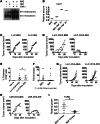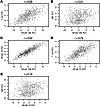Lung tumor NF-κB signaling promotes T cell-mediated immune surveillance
- PMID: 23635779
- PMCID: PMC3668836
- DOI: 10.1172/JCI67250
Lung tumor NF-κB signaling promotes T cell-mediated immune surveillance
Abstract
NF-κB is constitutively activated in many cancer types and is a potential key mediator of tumor-associated inflammation, tumor growth, and metastasis. We investigated the role of cancer cell NF-κB activity in T cell-mediated antitumor responses. In tumors rendered immunogenic by model antigen expression or following administration of antitumor vaccines, we found that high NF-κB activity leads to tumor rejection and/or growth suppression in mice. Using a global RNA expression microarray, we demonstrated that NF-κB enhanced expression of several T cell chemokines, including Ccl2, and decreased CCL2 expression was associated with enhanced tumor growth in a mouse lung cancer model. To investigate NF-κB function in human lung tumors, we identified a gene expression signature in human lung adenocarcinoma cell lines that was associated with NF-κB activity level. In patient tumor samples, overall lung tumor NF-κB activity was strongly associated with T cell infiltration but not with cancer cell proliferation. These results therefore indicate that NF-κB activity mediates immune surveillance and promotes antitumor T cell responses in both murine and human lung cancer.
Figures








Similar articles
-
Antitumor activity and immunomodulatory effects of the intraperitoneal administration of Kanglaite in vivo in Lewis lung carcinoma.J Ethnopharmacol. 2012 Sep 28;143(2):680-5. doi: 10.1016/j.jep.2012.07.025. Epub 2012 Jul 31. J Ethnopharmacol. 2012. PMID: 22867634
-
Knockout of the tumor suppressor gene Gprc5a in mice leads to NF-kappaB activation in airway epithelium and promotes lung inflammation and tumorigenesis.Cancer Prev Res (Phila). 2010 Apr;3(4):424-37. doi: 10.1158/1940-6207.CAPR-10-0032. Epub 2010 Mar 30. Cancer Prev Res (Phila). 2010. PMID: 20354164 Free PMC article.
-
Metastasis-Associated Protein 2 Represses NF-κB to Reduce Lung Tumor Growth and Inflammation.Cancer Res. 2020 Oct 1;80(19):4199-4211. doi: 10.1158/0008-5472.CAN-20-1158. Epub 2020 Aug 14. Cancer Res. 2020. PMID: 32816854
-
The complicated role of NF-kappaB in T-cell selection.Cell Mol Immunol. 2010 Mar;7(2):89-93. doi: 10.1038/cmi.2009.112. Cell Mol Immunol. 2010. PMID: 20190822 Free PMC article. Review.
-
Role of T cell-nuclear factor κB in transplantation.Transplant Rev (Orlando). 2012 Jul;26(3):189-200. doi: 10.1016/j.trre.2011.07.005. Epub 2011 Nov 8. Transplant Rev (Orlando). 2012. PMID: 22074783 Free PMC article. Review.
Cited by
-
A Detailed Catalogue of Multi-Omics Methodologies for Identification of Putative Biomarkers and Causal Molecular Networks in Translational Cancer Research.Int J Mol Sci. 2021 Mar 10;22(6):2822. doi: 10.3390/ijms22062822. Int J Mol Sci. 2021. PMID: 33802234 Free PMC article. Review.
-
Combination IFNβ and Membrane-Stable CD40L Maximize Tumor Dendritic Cell Activation and Lymph Node Trafficking to Elicit Systemic T-cell Immunity.Cancer Immunol Res. 2023 Apr 3;11(4):466-485. doi: 10.1158/2326-6066.CIR-22-0927. Cancer Immunol Res. 2023. PMID: 36757308 Free PMC article.
-
Pericyte-like spreading by disseminated cancer cells activates YAP and MRTF for metastatic colonization.Nat Cell Biol. 2018 Aug;20(8):966-978. doi: 10.1038/s41556-018-0138-8. Epub 2018 Jul 23. Nat Cell Biol. 2018. PMID: 30038252 Free PMC article.
-
MEK Inhibition Modulates Cytokine Response to Mediate Therapeutic Efficacy in Lung Cancer.Cancer Res. 2019 Nov 15;79(22):5812-5825. doi: 10.1158/0008-5472.CAN-19-0698. Epub 2019 Jul 30. Cancer Res. 2019. PMID: 31362929 Free PMC article.
-
CCL2: An Important Mediator Between Tumor Cells and Host Cells in Tumor Microenvironment.Front Oncol. 2021 Jul 27;11:722916. doi: 10.3389/fonc.2021.722916. eCollection 2021. Front Oncol. 2021. PMID: 34386431 Free PMC article. Review.
References
Publication types
MeSH terms
Substances
Associated data
- Actions
Grants and funding
LinkOut - more resources
Full Text Sources
Other Literature Sources
Medical
Molecular Biology Databases

